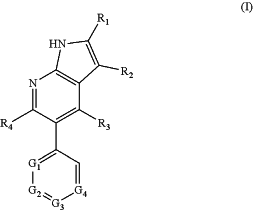| CPC A61K 31/437 (2013.01) [A61K 31/444 (2013.01); A61K 31/506 (2013.01); A61K 31/513 (2013.01); A61K 31/5377 (2013.01); C07D 471/04 (2013.01)] | 20 Claims |
|
1. A method for inhibiting HPK1 comprising contacting HPK1 with an effective amount of a compound of Formula I:
 or a pharmaceutically acceptable salt thereof, wherein,
G1 is N or C—Rx1;
G2 is N or C—Rx2;
G3 is N or C—Rx3;
G4 is N or C—Rx4;
wherein, 0, 1 or 2 of G1, G2, G3, and G4 is N;
Rx1, Rx2, Rx3 and Rx4, if present, in each instance, is independently selected from the group consisting of hydrogen, halo, C6-C20 aryl optionally substituted with one or two R1a, C1-C20 heteroaryl optionally substituted with one or two R1a, —CONR6R7, —NR6R7, and —N(R8)—CO(R9), provided that at least one of Rx1, Rx2, Rx3 and Rx4 is other than hydrogen;
wherein, R6 and R7 taken together with the N to which each is bound form a 4-, 5-, 6- or 7-member cyclic or heterocyclic ring, wherein said heterocyclic ring may contain one or two additional heteroatoms selected from the group consisting of N, S and O, said ring may be optionally substituted with one or two R1a; or
R6 and R7 are independently hydrogen or alkyl;
wherein, R8 and R9 taken together with the N or the carbonyl to which each is bound form a 4-, 5-, 6- or 7-member cyclic or heterocyclic ring, wherein said heterocyclic ring may contain one or two additional heteroatoms selected from the group consisting of N, S and O, said ring may be optionally substituted with one or two R1a; or
R8 and R9 are independently hydrogen or alkyl;
wherein, in each instance, R1a is independently taken together with the carbon to which it is bound to form a carbonyl; or R1a is hydrogen, alkyl, hydroxyl, hydroxyalkyl, halo or haloalkyl;
R1 is hydrogen, alkyl, hydroxyl, hydroxyalkyl, halo or haloalkyl;
R2 is alkyl, alkoxy, halo, haloalkyl-, haloalkoxy-, —R5—O—R5, —SO2R5, —SOR5, or cycloalkyl; and
R3 and R4, in each instance, is independently hydrogen, alkyl, alkoxy, halo, haloalkyl-, haloalkoxy-, —R5—O—R5, —SO2R5, —SOR5, or cycloalkyl;
wherein R5, in each instance, is independently an unsubstituted alkyl; provided that R1 and R4 are not both hydrogen.
|